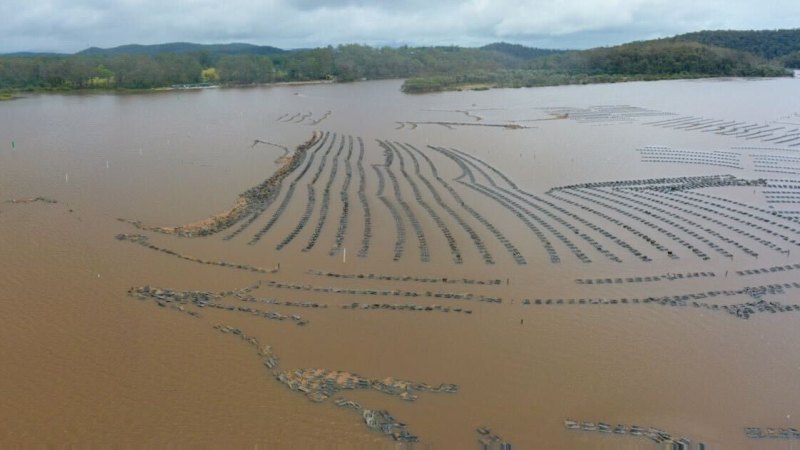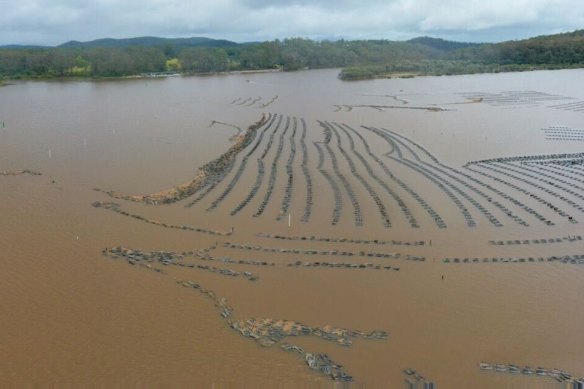Save articles for later
Add articles to your saved list and come back to them any time.
Oyster farmers along the South Coast should be ramping up for the busiest time of the year, but this Christmas recent heavy rain and flooding means there will be shortages.
The region is one of the most significant oyster-producing regions in Australia, producing about 60 per cent of the state’s total oyster production.
South Coast oyster farms, including Natural Oyster Co, were inundated by rainfall last week, impacting oyster supplies. Credit: Kelly Jones
Every estuary south of Sydney is currently closed for harvesting after heavy rainfall and floods smashed the area last week, with some areas receiving 250-300 millimetres. For example, Porters Creek received the most rainfall in 24 hours, with 351mm, while Jervis Bay recorded 226.8mm of rain, and Mourya saw 225mm.
Industry support officer Anna Simonds from Sapphire Coast Wilderness Oysters, a group on the South Coast that supports producers, said the current harvesting shutdown would be the biggest Christmas oyster shortage in some time.
“That is a loss of a key market, but on the flip side of that, the Northern Rivers oysters are producing and open for harvest, so hopefully they can come up and supply some of the shortfall,” she said.
“There will be very limited South Coast oysters available this Christmas. But for those people who have a preferred local supplier or producer, we’ll be back in the new year, and that’s when oysters are at their best.”
Kelly Jones, co-owner of Natural Oyster Co, located in Pambula, said logs and debris washed into their oyster leases, which will take weeks to clean up. But it will also impact the salinity levels of the lease, so the oysters cannot be harvested until the water returns to normal.
“We won’t be selling oysters before Christmas,” Jones said.
She added it will take some time for them to do water sampling and quality assurance to ensure the oysters are 100 per cent, which means they’ll be closed until early next year, like many oyster farmers in the region.
“My partner and I have a small business and we always look forward to the Christmas period for cash flow,” she said. “This flood couldn’t have come at a worse time.”
Jones urged people to come down and support farmers once they’re able to begin selling again.
The oyster industry has been hit hard in previous years, with floods and a deadly disease wiping out produce in parts of the state.
Since 2021, Port Stephens oyster farmers have been battling the QX disease that wiped out the entire Sydney rock oyster population in the region, which produces about 16 per cent of the state’s supply.
Tathra Oysters co-owner Gary Rodely said as long as there was no rain this weekend for the region, he hoped he might be able to open before Christmas.
But with a tropical cyclone looming off the coast of Australia, he was doubtful the skies would remain clear.
“That might put Christmas into further doubt if we get a big influx of rain over the weekend. We will be watching anxiously,” he said.
A spokesperson for the NSW Department of Primary Industries said: “Following the heavy rains and associated storm water and sewerage overflows last week along the south coast of NSW, 111 oyster farming business were required to automatically close for 21-days to ensure food safety.
“The NSW Food Authority is co-ordinating sampling to organise testing of oysters to open harvest areas as soon as possible. The NSW Department of Primary Industries (DPI) is in contact with industry leaders on the NSW south coast to receive updates and images of flood impacts.
“South Coast Oyster farmers remain optimistic that salty water will return to oyster farming lease quickly with tidal flushing.
“Industry leaders have been notified of assistance available following the joint state/Commonwealth declaration of a declared disaster,” the spokesperson added.
“This includes low-interest loans, transport and access to free support services. Consumers can be assured of the safety of oyster in the marketplace, harvested under a world-class shellfish safety program. Most oyster estuaries north of Nowra are open to harvest oysters, so supply will still be strong for consumers.”
Start the day with a summary of the day’s most important and interesting stories, analysis and insights. Sign up for our Morning Edition newsletter.
Most Viewed in Environment
From our partners
Source: Read Full Article

